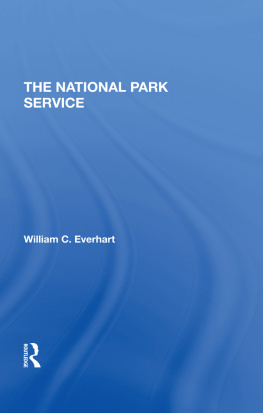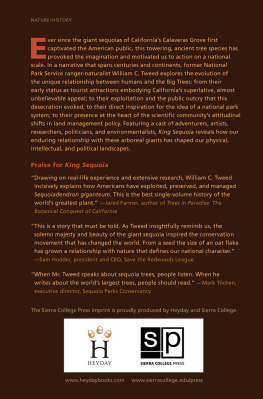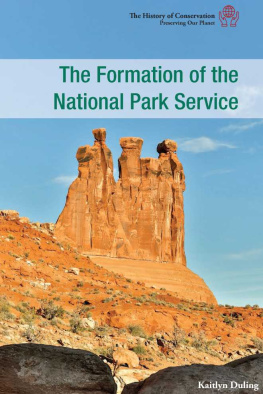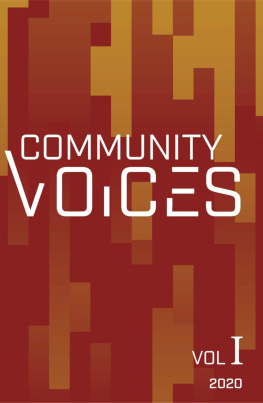The National Park Service
WESTVIEW LIBRARY OF FEDERAL DEPARTMENTS, AGENCIES, AND SYSTEMS
Ernest S. Griffith and Hugh L. Elsbree, General Editors
*The Library of Congress, Second Edition, Charles A. Goodrum and Helen W. Dalrymple
*The National Park Service, William C. Everhart
The Forest Service, Michael Frome
The Smithsonian Institution, Paul H. Oehser
The Bureau of Indian Affairs, Theodore W. Taylor
*Available in hardcover and paperback.
First published 1983 by Westview Press
Published 2019 by Routledge
52 Vanderbilt Avenue, New York, NY 10017
2 Park Square, Milton Park, Abingdon, Oxon OX14 4RN
Routledge is an imprint of the Taylor & Francis Group, an informa business
Copyright 1983 by Taylor & Francis
All rights reserved. No part of this book may be reprinted or reproduced or utilised in any form or by any electronic, mechanical, or other means, now known or hereafter invented, including photocopying and recording, or in any information storage or retrieval system, without permission in writing from the publishers.
Notice:
Product or corporate names may be trademarks or registered trademarks, and are used only for identification and explanation without intent to infringe.
Library of Congress Cataloging in Publication Data
Everhart, William C.
The National Park Service.
(Westview library of federal departments, agencies, and systems)
Bibliography: p.
Includes index.
1. United States. National Park Service. 2. National parks and reservesUnited
States. I. Title. II. Series.
SB482.A4E95 1982 353.00863 82-10884
ISBN 13: 978-0-367-29423-6 (hbk)
Contents
, Russell E. Dickenson
Guide
Figure
Tables
Photographs
(The photo section appears following Chapter 5, page 74.)
In the decade that has passed since the publication of the first edition of this book, the National Park Service has seen the strongest period of growth in its history. Today the Service has responsibility for more than 330 areas and sites, now embracing nearly 50 million acres. There have been important, and sometimes controversial, departures in the development of the national park system, ranging from major urban recreation areas to intergovernmental cooperative ventures to the great wilderness parks of Alaska.
It is most welcome that Bill Everhart now chooses to completely rewrite the earlier volume. His credentials for commenting on the National Park Sendee are as good as a man can have, given his years of experience first as a field historian and then as chief of interpretation for the Service. Immediately before his retirement, Bill gained added insights as a close adviser to two directors. Those insights are now brought to bear on the past and present of the National Park Service at a time in the Services history when opportunity and strain are combining to stretch minds and resources in a kind of sweet agony. With growth have come new levels of responsibility and new constituencies, amid the effects of inflation and a reduced staff.
As one reflects on the dimensions of the park system today, it is useful to remember that the concept of a system of places and structures to embrace the national patrimony is a relatively new idea. In the beginning the primary object was to set aside the greatest of the majestic wonders of the nation. Today that concept embraces a wide spectrum of resourcesnatural, historical, and recreationalthat taken together share a remarkable similarity to the geographic and ethnic pluralism of our culture. It is hard to imagine how even a conscious plan could have achieved so much so well.
It seems probable that the immediate period ahead will be a time of consolidation and a time for nurturing the growth of the last several years in ways that insure the permanence of the values held in stewardship by the National Park Service and its highly dedicated staff. This volume will sharpen our understandings of the past and the present and, I hope, serve to further fuel the enthusiasm of people both inside the Service and among the public to push ahead with the great work now underway. Much remains to be done. Our proud past can be a powerful prologue.
Russell E. Dickenson
Director, National Park Service
Park Service people, who are not loosely attached to their organization, know what Harold Nicholson meant when he said that his pulse quickened every time he saw the name Oxford, even on a jar of marmalade. At a time when it is fashionable to regard corporate loyalty as an amusing anachronism, nearly 200 members of the 1916 Society gathered in Washington, D.C., on August 25, 1981, for an evening of cocktails, dinner, and speechmaking by Park Service director Russ Dickenson and Interior Secretary James Watt. An easygoing fellowship with no bylaws, the society was formed by retired Park Service employees living in the Washington area for the sole purpose of holding a reunion every year on August 25, the date on which the National Park Service was created in 1916.
Convivial get-togethers of this kind are much favored by people who have lived and served together in U.S. national parks from Alaska to the Everglades. Park communities are often in remote locales where the winters are long and residents must ward off cabin fever. According to the wife of one Yellowstone superintendent, the surefire recipe for a rousing party is to set out a case of beer and casually mention the word bear .
Predictably, the program for the societys 1981 meeting was heavy on nostalgia, including an exchange of telephone greetings with colleagues holding similar sessions in Omaha, Denver, Santa Fe, Seattle, and San Francisco. The highlight of the evening was a telephone hookup with Horace Albright, a legendary figure who links the Park Service with its past. As a young assistant to the secretary of the Interior in 1916, Albright helped lobby the Park Service legislation through Congress. When the U.S. cavalry turned Yellowstone over to the Park Service after guarding the park faithfully for thirty years, Albright became its first civilian superintendent in 1919. In 1929, he became the second director of the Park Service.
Now ninety-one, and still blessed with a renowned memory capable of recalling the exact details of a chance meeting with John Muir in 1912, Albright has been the elder statesman of the organization for nearly half a century. Generations of Park Service people, myself included, have relished the hearty friendship and benefited from the tart advice of an exceptional man who continues to convey encouragement to his numberless friends across the country. In 1980 President Jimmy Carter sent his personal representative to California to bestow upon Horace Albright the nations highest civilian award, the Medal of Freedom, for his distinguished achievements in the field of conservation. One hopes this recognition will prove a good omen for the organization Horace has loved and served so well.
In case any reader may have overlooked the clues, the Park Service comes closer to being a tribal clan than a government agency. In its early years it was shaped by a resourceful group of gifted amateursAlbright was one of themfor the craft of administering a park system, developing a guiding philosophy, and training a corps of rangers had to be learned from scratch. There were no examples to follow and no books on the subject.





